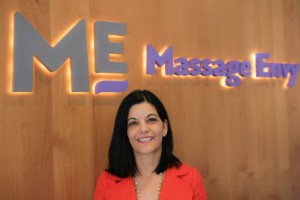Earlier this year Massage Envy, the pioneer and largest national therapeutic message and skincare franchise, announced a rebranding strategy to appeal to Boomers and Millennials (Madov, 2016). According to Debbie Gonzalez, Massage Envoy’s Chief Brand Officer, the franchisor hopes to make the brand more modern and approachable to Boomers and Millennials because they see wellness as an important part of their lives: “Boomers are aging and becoming more health and wellness focused” and Millennials “already come to this space with that mentality (Madov, 2016, p. 3). Capitalizing on this cultural shift, the company launched a revamped version of their “Because Everything” campaign this year. “Because Everything” aims to shift the perception of massages as a luxury or treat to showing how they can help people deal with daily aches and pains or common injuries (Madov, 2016). The campaign includes digital marketing and social media, as well as advertising and PR outreach. To date, the company has bought national time and individual franchises have bought spots in local markets.
The Massage Envy rebranding case illustrates the touch-point strategy, as described by Young (2014), of selecting media by clearly defining one’s communication objectives. Arguably, Massage Envy’s two-pronged communication objectives are (1) to create brand awareness among Millennials and Boomers and (2) to shift people’s perception of massages from a luxury to a necessary aspect of one’s well-being. The media mix for this campaign, as mentioned earlier, consists of television, online (digital, social), and PR outreach.
While it is difficult to determine the success of Massage Envy’s ongoing campaign because the company has yet to release any reports, one can predict how each channel and/or platform will influence the effectiveness of the overall campaign. Young (2014) suggests that different media offer different benefits: magazines can prompt response and action while online media can drive brand familiarity. To illustrate this point, the author delves into a case study on Sara Lee International’s successful campaign for their tea brand Pickwick. Sara Lee International leveraged television (43%), print (48%), and online (8%) media over a 15-week period, ultimately increasing product awareness, purchase intent, and position awareness by 36%, 35%, and 20%, respectively (Young, p. 135). For example, Young writes that Sara Lee’s tea campaign effectively leveraged television to generate awareness about the product and online media to drive brand familiarity (2014, p. 135). Massage Envy’s media mix, especially television and online, may help the brand to accomplish its two-fold communication objectives: brand awareness and redefining massages, but that’s to be determined.
Apart from stating that different media offer brands unique benefits, Young (2014) presents three main inputs for touch point selection: data, consumer insight, and communication needs (Anthony, 2014, pp. 136-138). A touch point is any way a consumer interacts with a business, such as through a website, television, or any form of communication (Young, 2014, p. 136). While an exhaustive analysis of the three inputs is beyond the scope of this blog post, briefly data encompasses all data-led decision-making processes (e.g., market-mix modeling, performance marketing, and audience reach and frequency). Consumer insight takes into account culture and media consumption, receptivity insights, etc., and by communication role, the author advises communication planners to take into account how a brand can create differentiation and cut through as well as amplify the central communication idea to guide touch point selection and use (Young, 2014, p. 137). Massage Envy has not published extensive reports relating to its touch point selection, except that the brand’s new ads feature men. This marketing approach makes sense because the company has found that its current client base is 25% male, and they hope to attract more males (Young, 2014, p. 6). In spot ad below, for instance, Massage Envy appeal to both genders by offering to help potential clients manage the side effects of scenarios they encounter on a daily basis, from playing football, to dancing at a wedding, and watching television.
https://www.youtube.com/watch?v=lxBr51IjkAg&nohtml5=False
As Massage Envy publishes reports on its 2016 “Because Everything” campaign, it will be interesting to see how successful, if at all, the campaign is at achieving its core communication objectives. If the campaign fails to create brand awareness among its target demographics and to redefine massages from a treat to a necessary aspect of one’s well-being, one may want to consider if the issue was with the brand’s touch point selection and use.
Sources
Madov, N. (2016, April 12). Massage Envy changes its message to appeal to Millennials and Boomers. Ad Age. Retrieved from http://adage.com/article/cmo-strategy/massage-envy-reinvents-wellness-brand/303489/


7 Responses to Massage Envy’s Rebranding Efforts: A Touch Point Selection Perspective